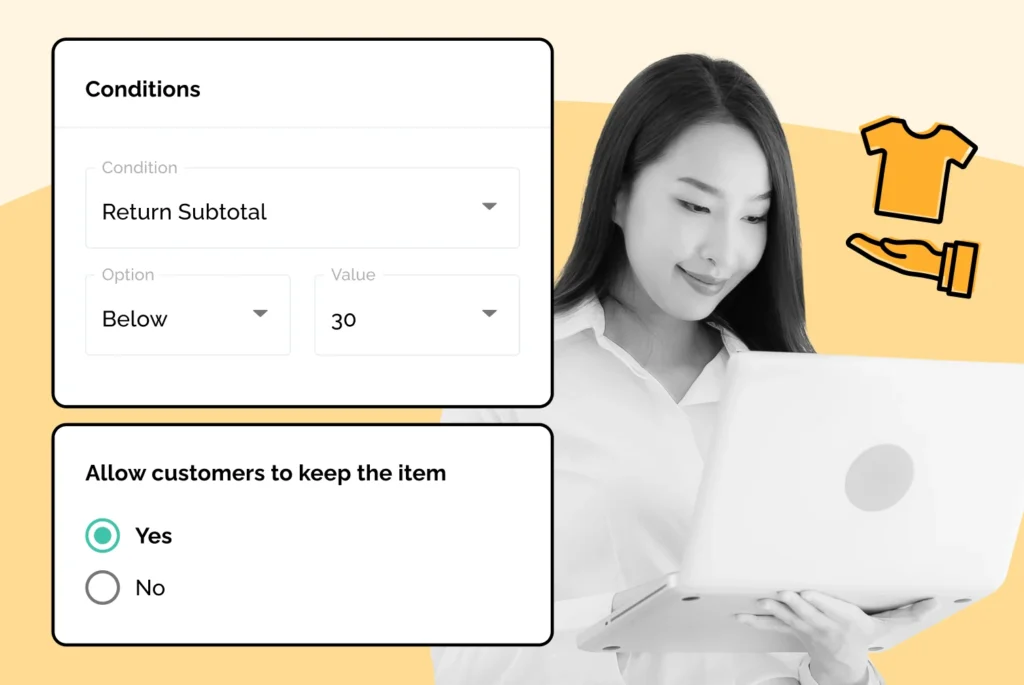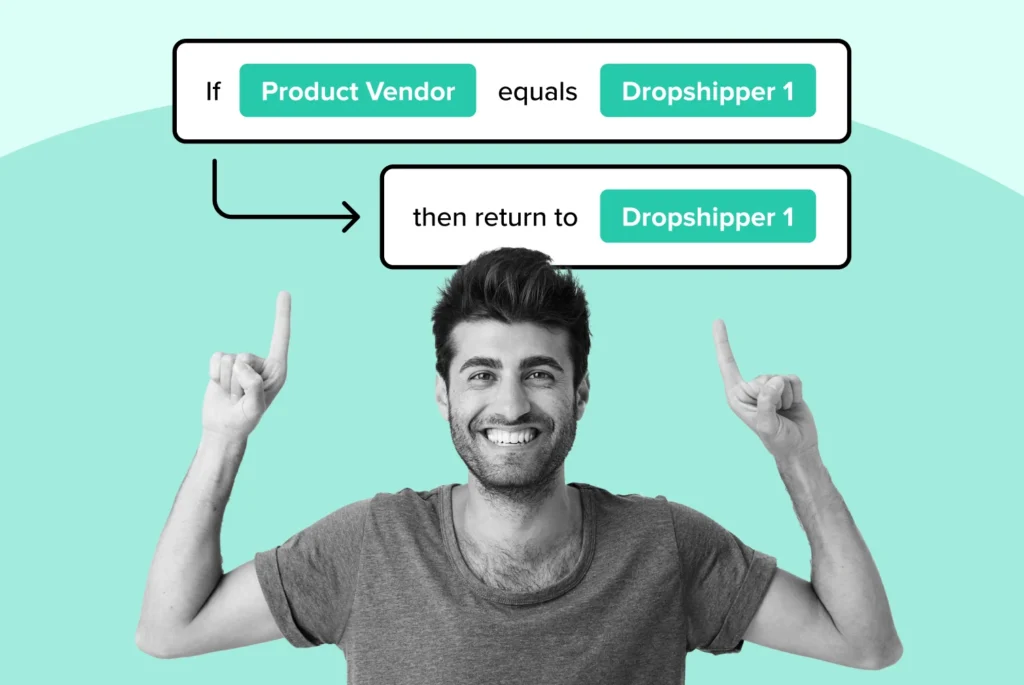
The Top Influencers on Return Behavior in Ecommerce
Let’s unpack effective strategies to influence return behavior that balance customer needs with business viability!
Shipping, Tracking & Notifications
Boost customer experience and reduce support tickets
Realtime order and shipment tracking
Proactive order and shipping notifications
AI-Enhanced Discounted Labels
Predictive pre-purchase estimated delivery dates
Self-Serivce branded order tracking
Effortless experience delivered
Identify and Resolve Order Issues
Realtime order and shipment tracking
Make returns profitable and delight customers
Flexibility to define any return destinations & conditions
Simplify returns for your customers and team
Incentivize exchanges over returns
Returns management made easy for your team
Returns management made easy for your team
Understand why your customers are returning
In-Store & Curbside Pickup
Unify the online and the in-store experience
Hassle-free pickup experience for customers
In-Store dashboard to keep operations streamlined
In-Store and Online orders unified
Drive foot-traffic to your stores
Shipping, Tracking & Notifications
Boost customer experience and reduce support tickets
Realtime order and shipment tracking
Proactive order and shipping notifications
AI-Enhanced Discounted Labels
Predictive pre-purchase estimated delivery dates
Self-Serivce branded order tracking
Effortless experience delivered
Identify and Resolve Order Issues
Realtime order and shipment tracking
Make returns profitable and delight customers
Flexibility to define any return destinations & conditions
Simplify returns for your customers and team
Incentivize exchanges over returns
Returns management made easy for your team
Returns management made easy for your team
Understand why your customers are returning
In-Store & Curbside Pickup
Unify the online and the in-store experience
Hassle-free pickup experience for customers
In-Store Dashboard to keep operations streamlined
In-Store and Online orders unified
Drive foot-traffic to your stores
Boost customer experience and reduce support tickets
Realtime order and shipment tracking
Proactive order and shipping notifications
AI-Enhanced Discounted Labels
Predictive pre-purchase estimated delivery dates
Self-Serivce branded order tracking
Effortless experience delivered
Make returns profitable and delight customers
Flexibility to define any return destinations & conditions
Simplify returns for your customers and team
Incentivize exchanges over returns
Returns management made easy for your team
Equip your team for precise return checks.
Understand why your customers are returning
Unify the online and the in-store experience
Hassle-free pickup experience for customers
In-Store Dashboard to keep operations streamlined
In-Store and Online orders unified
Drive foot-traffic to your stores
Find the answer to all your questions
Take a step by step trip through our functionality to see how we can improve your ecommerce processes.
Explore the most comon questions about WeSupply
Calculate the ROI that WeSupply can bring you
Request a no strings attached review of your current shopping experience and missed conversion opportunities
Read actionable articles on how to optimize your post-purchase experience and decrease support tickets
Get inspired by stories of how our customers implemented an effortless post-purchase experience
Wondering if WeSupply is a good fit for you? Read through our use cases to see how we can help you increase conversion & improve CX!
A Deep Dive into Top Companies' Order Tracking & Returns Strategy
Find the answer to all your questions
Explore the most comon questions about WeSupply
Calculate the ROI that WeSupply can bring you
Request a no strings attached review of your current shopping experience and missed conversion opportunities
Take a step by step trip through our functionality to see how we can improve your ecommerce processes.
Read actionable articles on how to optimize your post-purchase experience and decrease support tickets
Get inspired by stories of how our customers implemented an effortless post-purchase experience
A Deep Dive into Top Companies' Order Tracking & Returns Strategy
Wondering if WeSupply is a good fit for you? Read through our use cases to see how we can help you increase conversion & improve CX!

Are you grappling with the challenge of managing ecommerce returns? Understanding return KPIs is crucial for any online retailer aiming to reduce costs and improve customer satisfaction. In this article, we dissect essential ecommerce return KPIs that will help you measure and analyze your returns process effectively. Expect to gain clarity on which metrics to track, why they’re significant, and how they can guide your strategies toward minimizing returns and enhancing customer loyalty.
Ecommerce return KPIs are critical for monitoring performance and understanding customer behavior, shifting from cost-centered to customer-centric strategies to enhance customer experiences and brand loyalty.
Essential ecommerce return KPIs include Customer Acquisition Cost (CAC), Conversion Rate (CR), Average Order Value (AOV), Repeat Purchase Rate (RPR), and Return Rate, and their regular tracking can inform strategic decisions to drive growth.
To effectively manage return KPIs, businesses should leverage technological tools like return management software and analytics platforms, and implement strategies such as enhancing product quality and streamlining return processes for improved customer experience.
WeSupply revolutionizes eCommerce by enhancing post-purchase experiences and streamlining returns, focusing on CSAT and NPS for continuous improvement. It shifts towards a customer-centric approach, using data-driven insights to reduce returns and boost profitability. Automated returns, proactive notifications, and analytics reduce Customer Acquisition Cost (CAC), lower cart abandonment, and increase conversion rates. WeSupply’s seamless checkout and returns management foster customer loyalty and operational efficiency. Optimize your eCommerce returns and customer satisfaction with WeSupply. Dive in today!
In the vast expanse of the ecommerce universe, data is the guiding star that navigates businesses towards success. Key Performance Indicators (KPIs) are the constellations that help ecommerce businesses monitor their performance, understand customer behavior, and chart the course towards growth. Among these, ecommerce return KPIs often don’t get the attention they deserve. They offer a comprehensive view of business performance across various aspects.
Ecommerce marketers can optimize strategies and make informed decisions when they systematically track and analyze these KPIs. In essence, ecommerce return KPIs are the compass that guides ecommerce brands through the turbulent waters of online sales.
In the realm of ecommerce, KPIs are no less than a beacon. They act as diagnostic tools that help in evaluating performance, identifying strengths and weaknesses, and informing strategic planning. Critical KPIs like conversion rates, average order value, and customer acquisition cost directly influence a company’s financial health and customer satisfaction. They serve as navigational tools, offering quantifiable measurements that guide strategic decision-making in performance marketing.
Ecommerce businesses can identify strengths to exploit and weaknesses that need addressing to stimulate growth by tracking KPIs. Moreover, KPIs help evaluate the return on investment of marketing initiatives, helping determine the viability of campaigns and resource allocation. Hence, KPIs play a pivotal role in shaping the success of modern ecommerce businesses.
The world of ecommerce is ever-evolving. Today, businesses are transitioning from traditional financial metrics to KPIs that prioritize customer experience and satisfaction, such as Customer Satisfaction (CSAT) and Net Promoter Score (NPS). This shift from traditional metrics to new, customer-centric approaches signifies a paradigm change. Ecommerce businesses are realizing that focusing solely on financial metrics may not paint the complete picture.
Instead, a more holistic view that includes customer-centric metrics can provide a more accurate understanding of the business’s performance. This shift underscores the importance of customer satisfaction in modern ecommerce and the significant role it plays in shaping business success.
WeSupply champions a shift towards new, data-driven ways of understanding business success. They emphasize the power of analytics in improving customer experiences post-purchase. By enabling businesses to measure Customer Satisfaction (CSAT) and Net Promoter Score (NPS), WeSupply supports the fine-tuning of services based on customer feedback. This approach helps businesses not just identify problems, but understand their causes—whether it’s order processing, product quality, or something else—making it easier to address and solve these issues effectively.
With the shift towards customer-centric metrics, the importance of return KPIs becomes even more pronounced. Monitoring these KPIs can aid in identifying patterns in returns, which then assists in addressing the root causes and improving the customer experience. The returns experience itself can significantly enhance repeat purchase rates and can be instrumental in forging strong customer relationships.
Businesses can better navigate the complex landscape of ecommerce returns, enhance their customer experience, improve their product offerings, and ultimately drive business growth by focusing on return KPIs.
The evolution of return metrics has been a fascinating journey. Initially, ecommerce businesses viewed returns primarily as a cost center, avoiding offering them to save money. However, over time, they recognized that a positive returns experience could lead to increased customer loyalty and repeat purchases. Return KPIs enable ecommerce businesses to shift their focus from solely cost management to enhancing customer loyalty and satisfaction.
This shift has transformed the perception of returns from being a cost-center to an opportunity for building strong customer relationships and increasing repeat purchases. For instance, a positive returns experience can lead to a fourfold increase in repeat purchase rates. This significant shift underscores the strategic value of return KPIs in ecommerce.
WeSupply represents a pivotal shift in post-purchase strategies, moving from traditional cost-centric metrics to a customer-centric approach. As a post-purchase software, it redefines the return process by focusing on enhancing customer satisfaction and loyalty. By analyzing return metrics through a customer-centric lens, WeSupply helps businesses understand and improve the return experience, aligning with modern consumers’ expectations for convenience, speed, and communication. This evolution signifies a deeper understanding of returns not just as a cost to be minimized, but as an opportunity to strengthen customer relationships and build brand loyalty.
Ecommerce return KPIs are not just about return rates; they also deliver invaluable insights into customer purchasing behaviors and help assess the effectiveness of the returns process. Analyzing the reasons behind product returns provides valuable insights into potential product issues or customer dissatisfaction, influencing future quality checks and reducing customer churn. Monitoring the most frequently returned products can indicate broader issues within certain item categories, helping businesses make more informed decisions regarding sourcing or product adjustments.
Understanding the preferred methods of return, such as refunds, exchanges, or store credits, can help businesses strategize to retain revenue by promoting exchanges and store credits over refunds. These insights can help ecommerce businesses optimize their return strategy for improved customer satisfaction and increased profitability.
WeSupply offers valuable insights into customer behavior and store performance, focusing on optimizing the return process. By analyzing returns analytics, businesses can understand why certain products are frequently returned and identify patterns among serial returners. This intelligence allows for targeted strategies to reduce return rates through actionable insights. Additionally, by identifying the most exchanged products and collecting customer feedback, WeSupply helps businesses streamline processes, refine products, and adjust return policies, aiming to improve profit margins and recover revenue that might otherwise be lost. Understanding the financial impact of returns and exchanges enables a more strategic approach to business optimization and customer satisfaction.
Now that we’ve explored the importance of return KPIs, let’s expand our understanding to include the primary ecommerce return KPIs. These KPIs play a crucial role in shaping the business’s success:
Customer Acquisition Cost (CAC)
Conversion Rate (CR)
Average Order Value (AOV)
Repeat Purchase Rate (RPR)
Return Rate
Each KPI offers a wealth of information, helping businesses identify strengths and weaknesses, and chart the course for growth.
This section will serve as a guide, providing an in-depth understanding of each KPI and its impact on your business.
One of the fundamental KPIs that significantly impacts return rates is the Customer Acquisition Cost (CAC). This metric encompasses the total expenses related to gaining a new customer, such as marketing, production, storage, and shipping of purchased items. A high CAC could be linked to low conversion rates or expensive marketing efforts, which need to be investigated and adjusted.
Reducing CAC can be a significant challenge and opportunity for ecommerce marketers, involving initiatives like channel diversification and optimization efforts. By understanding and reducing the CAC, businesses can optimize their marketing strategies and improve return on investment.
WeSupply plays a pivotal role in reducing Customer Acquisition Cost (CAC) by transforming the returns process into a strategic opportunity for customer retention and increased spending. By converting returns into exchanges, and incentivizing customers to opt for exchanges or store credit over traditional refunds, businesses can maintain sales momentum and potentially boost the average order value. WeSupply facilitates this by making exchanges straightforward and rewarding for customers, encouraging them to revisit the product catalog and select items of equal or greater value. Offering refunds as store credits not only encourages repeat shopping, but also fosters a trusting relationship with customers. This approach not only saves on the costs associated with acquiring new customers but also enhances the Customer Lifetime Value (CLV) through increased order values and ongoing engagement.
Conversion Rate (CR) is another critical KPI that has a direct link with returns policies and purchase confidence. An optimized CR can lead to a higher number of visitors taking desired actions, such as making purchases, which may reduce the likelihood of returns due to increased purchase confidence. Businesses with a robust CR may gain competitive advantages, possibly influencing return rates positively, as high conversion rates can indicate better customer satisfaction and less need for returns.
This metric serves as a mirror, reflecting the effectiveness of your return policies and their impact on customer purchase decisions.
WeSupply boosts conversion rates (CR) by linking returns policies with customer confidence, making the shopping experience worry-free and encouraging purchases. Key features include:
Smart return rules tailored to item attributes, with customizable conditions like free return shipping.
Intelligent sorting of physical returns for efficiency.
WeSupply’s integrations with top review platforms (Stamped, Yotpo, Okendo, Junip, Reviews.io) allow businesses to:
Collect and display reviews, ratings, and user-generated content.
Enhance trust and encourage purchases by highlighting positive customer feedback.
These strategies create a seamless and reassuring shopping journey, directly impacting conversion rates positively.
Average Order Value (AOV) is a significant KPI that helps businesses maximize revenue per customer. By improving AOV, businesses can positively impact Customer Lifetime Value (CLV) as both metrics are interconnected. A higher AOV leads to increased revenue and can suggest a faster path to profitability as well as a greater return on investment. Understanding the AOV gives insights into revenue per customer, aiding in business strategy decisions like offering free shipping to boost sales.
Specific tactics to increase AOV include:
Optimizing product page design
Highlighting trending products
Offering social proof
Personalizing the shopping experience
Setting free shipping thresholds.
WeSupply boosts Average Order Value (AOV) by maximizing revenue through seamless exchanges and smart integrations, making shopping worry-free and encouraging higher-value purchases. Key contributions include:
Building trust with reviews and user-generated content through integrations with platforms like Stamped and Yotpo.
Offering flexible, customer-friendly return policies with smart return rules.
Additionally, WeSupply’s Justuno App integration enhances the post-purchase experience:
Personalized product recommendations based on customer history.
Upsell and cross-sell strategies to elevate order value.
Highlighting top products to encourage additional purchases.
These strategies collectively improve the shopping experience and strategically drive up the average order value.
RPR is a crucial KPI that aids in cultivating customer loyalty. A high RPR signifies strong brand loyalty, suggesting that customers are satisfied with the product or service quality. Stable revenue and higher profit margins are often outcomes of a high RPR, as repeat customers may contribute more to revenue over time and incur lower marketing costs.
Focusing on enhancing RPR can be more cost-efficient in marketing as retaining existing customers is generally less expensive than acquiring new ones. By keeping track of RPR, businesses can foster customer loyalty, leading to increased customer satisfaction and recurring revenue.
WeSupply boosts Repeat Purchase Rate (RPR) by cultivating customer loyalty with proactive return notifications and personalized offers. Key features include:
High open rates for email and SMS notifications, ensuring customers stay informed.
Custom deals via post-purchase communication to encourage repeat business.
Eliminating customer-initiated check-ups, enhancing overall satisfaction.
This streamlined communication strategy strengthens customer loyalty and promotes repeat purchases.
Another essential KPI is the return rate, which helps in analyzing and mitigating product returns. A high return rate can indicate customer dissatisfaction and potential product issues. By analyzing return rates, businesses can measure customer satisfaction and identify reasons for product returns, enabling corrective actions.
Factors influencing the ecommerce return rate include customer dissatisfaction with the product, sizing issues, or discrepancies between the product’s online description and the actual item. Understanding these factors can help businesses take proactive measures to reduce return rates and enhance customer satisfaction.
Balancing the refund rate and the exchange rate is a vital part of revenue retention. Ideally, for an ecommerce store, the exchange rate should be higher than the refund rate to prevent loss of revenue and enhance customer experience. Tracking the exchange rate provides insights into whether a brand is successful in encouraging customers to choose exchanges over refunds.
A return signifies a loss of revenue for an ecommerce business, while an exchange represents the retention of that revenue. Therefore, understanding the nuances of refund and exchange rates can help businesses develop strategies that promote customer satisfaction while retaining revenue.
WeSupply streamlines the balance between refund and exchange rates for eCommerce, vital for revenue retention. It enables businesses to identify and analyze frequently returned products and the reasons behind these returns, effectively reducing return rates with actionable insights. By highlighting products with high exchange potential, gathering direct customer feedback, and understanding the financial implications of returns versus exchanges, WeSupply not only aids in retaining revenue by promoting exchanges over refunds but also improves product offerings and policies. This cohesive approach fosters customer loyalty while enhancing profitability.
Returns Analytics for eCommerce Business
Book a quick call with our experts to see how WeSupply can help you understand why your customers are returning: identify the most returned products, understand why those products are returned, identify which customers are serial returners, reduce Return Rate with Actionable Insights!
Cost per return is a key KPI for evaluating the financial impact of returns. The cost of returns encompasses both direct expenses, such as shipping, restocking, and refurbishment, and indirect costs like inventory depreciation, labor, and effects on brand reputation. Return costs significantly influence retail profitability and demand a strategic approach to optimize operations.
By utilizing return management software and analyzing return patterns and reasons, businesses can make improvements in operations and product offerings, thereby reducing the cost of returns and enhancing profitability.
WeSupply helps reduce the financial impact of returns, boosting ROI for eCommerce operations. It offers insights and strategies to lower the Cost per Return, enhancing profitability and customer satisfaction. By optimizing returns management, businesses save money and turn a potential challenge into a strategic asset. Maximize your ROI with WeSupply. Use our ROI Calculator to see how!
While the primary return KPIs provide a wealth of insights, it’s also essential to delve into secondary ecommerce metrics that affect returns. These metrics, such as customer retention rate and churn rate, offer additional layers of insight into your ecommerce operations.
A consumer survey revealed that 96% of online shoppers examine return policies prior to making a purchase, indicating the significant influence these policies have on purchasing decisions. Shoppers’ post-purchase experiences, including returns, are increasingly important in their relationship with brands, suggesting that the handling of returns can affect long-term customer loyalty.
Retaining customers is a crucial aspect of any business, and ecommerce is no exception. Customer retention rate is a measure of a company’s ability to keep its customers over a specific period. A high customer retention rate is indicative of strong brand loyalty and customer satisfaction. On the other hand, a high customer churn rate indicates that customers are discontinuing their purchases, which could negatively impact a brand’s revenue. This suggests that the brand’s strategies may not be aligning with customer needs.
By monitoring these metrics, businesses can assess brand loyalty, identify potential issues, and take corrective actions to enhance customer satisfaction and retain more customers.
Net Promoter Score (NPS) is a crucial metric that measures customer satisfaction and referral potential. NPS surveys can be conducted regularly to gauge customer satisfaction levels and obtain actionable feedback for improving the customer experience. High NPS scores are correlated with higher growth rates in companies, emphasizing the importance of customer loyalty for business success.
By analyzing NPS, ecommerce businesses can:
Gauge the loyalty of their customers
Identify areas for enhancing customer satisfaction
Retain customers and turn them into promoters of the brand
Generate more referrals and attract new customers.
WeSupply underscores the importance of leveraging analytics and data-driven decisions to enhance business performance, especially through measuring customer satisfaction and referral potential via Net Promoter Score (NPS). By providing tools to track NPS alongside Customer Satisfaction (CSAT), WeSupply enables businesses to gauge the effectiveness of their post-purchase customer experience. This focus on continuous measurement and improvement ensures that companies can delight loyal customers and adapt to their evolving needs, fostering a cycle of positive feedback and high referral potential. Ready to transform your post-purchase experience? Book a demo with WeSupply now and see the difference firsthand!
Now that we’ve explored the landscape of return KPIs and their importance, it’s time to delve into strategies for mastering them. Implementing effective strategies can significantly enhance store performance, profitability, and customer retention. Here are some approaches that can help businesses optimize their return KPIs:
Enhancing product quality
Streamlining the returns process
Leveraging data analytics
Driving customer retention
By implementing these strategies, businesses can improve their return KPIs and achieve better overall performance.
These strategies are not only about reducing return rates but also about enhancing the customer experience and forging stronger customer relationships.
One effective strategy to reduce returns is to enhance product quality. Analyzing product return rates can provide insights into customer satisfaction and help pinpoint issues that need addressing to improve product quality.
Improving customer service messaging can bolster customer experiences and reduce returns by offering immediate and convenient support. Moreover, providing detailed product descriptions and accurate images can lead to better customer expectations and reduce return rates. By having a responsive customer support team, businesses can ensure that their customers receive the assistance they need.
Offering a comprehensive size guide or virtual fitting tools can minimize returns due to sizing issues. Regularly gathering customer feedback on products can inform improvements and lead to higher satisfaction rates.
Streamlining the returns process is another effective strategy for reducing returns and enhancing the customer experience. A straightforward returns process bolsters customer satisfaction and may influence their decision to make future purchases with the retailer. Prioritizing customer support through quick messaging channels like SMS can streamline the returns process, providing speedy solutions and enhancing the customer experience.
Returning products via automation can reduce manual errors and speed up the process, thus improving the customer’s experience in an online store. By providing multiple return options and efficiently managing and reintegrating returned inventory, businesses can enhance the overall shopping experience and reduce financial losses.
WeSupply significantly streamlines the returns process, enhancing the customer experience and fostering loyalty. By optimizing returns, WeSupply ensures a more efficient and satisfying post-purchase journey for customers. Key features include:
Branded Returns Portal: Offers a seamless, branded returns experience, avoiding generic third-party solutions.
Self-Service Returns: Empowers customers with a frictionless, self-service return process.
Flexible Returns Rules: Adapts return policies to fit various use cases, making returns hassle-free.
QR Code Return Labels: Simplifies returns with easy-to-use, autogenerated QR code labels.
Returns Tracking: Provides customers with the ability to track their returns easily, enhancing transparency and trust.
Post-Purchase Notifications: Keeps customers informed and engaged with high open-rate email and SMS notifications.
Seamless Integrations: Integrates with numerous third-party tools, connecting order and return data effortlessly.
WeSupply’s comprehensive approach not only saves time but also secures customer satisfaction and loyalty through a smoother returns experience. Streamline your returns and elevate customer satisfaction with WeSupply. Book your demo today and see the difference!
Leveraging data analytics is a powerful strategy for making insightful decisions. Ecommerce return KPIs provide valuable data regarding revenue, customer behavior, and return trends for informed decision-making. Automation rules in customer service platforms can help prioritize and segment tickets, allowing for more informed decision-making based on customer interaction data.
Data analytics assist ecommerce businesses in:
Understanding customer behavior, preferences, and purchase patterns
Tailoring offerings and optimizing the user experience
Enhancing customer satisfaction
Increasing conversion rates
Improving customer lifetime value
WeSupply positions data analytics at the heart of strategic decision-making, offering tools to track Customer Satisfaction (CSAT) and Net Promoter Score (NPS) for improving post-purchase experiences. It provides detailed order analytics, such as order statuses, processing times by location, and insights into orders received, shipped, canceled, and delivered. This comprehensive data enables businesses to refine their order management and delivery processes, making informed decisions to enhance customer satisfaction and efficiency. By leveraging WeSupply’s analytics, companies can optimize their operations and deliver a seamless customer journey from start to finish.
Driving customer retention and minimizing churn is a strategic initiative that can significantly enhance return KPIs. Here are some ways to achieve this:
Provide a hassle-free return experience to make customers more likely to return for future purchases
Proactively reach out to customers via SMS with important updates and timely discounts
Analyze the reasons why churn occurs and proactively address those reasons
By implementing these strategies, you can increase customer retention and reduce churn.
Engagement with customers through various channels, such as:
email marketing
social media
live chat
customer surveys
can help prevent churn by showing them the value of the products. Educational materials and support for customers can promote retention and diminish the likelihood of churn.
WeSupply is a pivotal tool in driving customer retention and minimizing churn by streamlining the returns process and enhancing post-purchase communication. Through automation and analytics, it offers a seamless return experience and keeps customers engaged, turning potentially negative experiences into opportunities for loyalty building. Key features include:
Returns Analytics: Provides insights into return patterns, helping to identify the most returned products and the reasons behind them.
Boost your customer retention and streamline your returns with WeSupply. Book your demo today and start transforming your post-purchase experience!
As businesses strive to optimize their return KPIs, technological tools can provide much-needed assistance. From return management software to analytics platforms, these tools can automate processes, provide deep insights, and help businesses make data-driven decisions. Monitoring return KPIs enables ecommerce stores to understand and address the underlying causes of product returns, potentially leading to reduced costs and increased customer satisfaction.
Next, we’ll discuss how these technological tools can aid in optimizing return KPIs.
Return management software is a powerful tool that can automate and simplify returns. It can streamline the returns process by:
Automating workflows
Providing customers with easy-to-use return solutions
Providing a centralized system for merchants to manage returns
Assessing product conditions
Taking actions like refunds or exchanges
This enhances operational efficiency.
Merchants can use return management software to analyze return patterns and reasons, which can lead to improvements in operations and product offerings. Thus, return management software can significantly enhance the returns process, leading to increased customer satisfaction and improved return KPIs.
WeSupply’s Automated Returns Management simplifies and automates the return process, enhancing both efficiency and customer satisfaction. Key features include:
24/7 Returns Processing: Facilitates hassle-free returns anytime, without customer support tickets.
Automated Return Rules: Streamlines returns with automated labels and notifications.
Flexible Approval Settings: Offers auto or manual approval for returns, tailoring the process to item value.
Fraud and Error Reduction: Prevents return fraud and minimizes human errors in restocking fees and label generation.
This system not only accelerates the return process but also significantly reduces fraud and errors, ensuring a smooth and trustworthy return experience for customers.
Analytics platforms are invaluable tools that can provide deep insights into return trends and behaviors. These platforms enable ecommerce businesses to:
Gain deep insights into customer behavior
Identify pain points in the customer journey
Use data to optimize the shopping experience to potentially reduce returns
Make AI-driven decisions and use machine learning algorithms to gain a holistic view of performance.
Personalized shopping experiences informed by data analytics are more likely to result in conversions and higher customer lifetime value. Thus, analytics platforms can provide invaluable insights, helping businesses optimize their return KPIs and enhance their customer experience.
WeSupply, seamlessly integrated with BigQuery, stands at the forefront of enhancing analytics platforms by offering deep insights into return trends and customer behaviors. This integration not only streamlines data analysis but also enriches the decision-making process for businesses. By leveraging WeSupply’s capability to work in harmony with various analytics tools, organizations can gain a comprehensive understanding of their return dynamics, enabling them to optimize their strategies and improve customer satisfaction. This holistic approach to data integration positions WeSupply as a key player in unlocking valuable analytics for informed business decisions.
While mastering return KPIs is crucial, it’s equally important to explore innovative approaches to reduce return rates and enhance the Repeat Purchase Rate (RPR). These approaches, such as providing detailed and accurate product descriptions, using quality images, and offering product videos, can help reduce ecommerce returns by minimizing customer confusion over products.
Next, we’ll explore these innovative approaches and their potential to reduce return rates and boost RPR.
Loyalty programs are a proven strategy for encouraging repeat purchases and increasing Average Order Value (AOV). These programs can lead to increased AOV as loyal customers often spend more per transaction than new customers. Implementing a loyalty program that rewards customers for repeat purchases can enhance customer lifetime value (CLV) by promoting sustained engagement.
Satisfied repeat customers can become brand advocates, sharing positive word-of-mouth recommendations that contribute to the brand’s reputation and visibility. Thus, loyalty programs can significantly enhance customer loyalty, leading to increased customer satisfaction and recurring revenue.
Cart abandonment is a major challenge faced by ecommerce businesses, and optimizing the checkout experience can significantly reduce cart abandonment rates. The primary reasons for customers abandoning the checkout process are:
Unexpected additional charges
Forced account creation
Complex and lengthy checkout processes
Perceived inadequate payment security
Slow website load times
By addressing these issues, businesses can improve the checkout experience, leading to lower cart abandonment rates and increased sales.
WeSupply optimizes the checkout experience by displaying estimated delivery dates at key stages—product pages, carts, checkout, and shipment notifications—reducing cart abandonment by setting clear expectations. This transparency addresses shipping anxieties, boosts customer trust, and significantly enhances conversion rates by 24%, encouraging more completed purchases without extra costs.
Having explored the landscape of ecommerce return KPIs and strategies to master them, it’s time to delve into actionable steps for tracking and improving these KPIs. Effective tracking of ecommerce KPIs starts by:
Aligning them with your business goals
Ensuring they’re measurable
Relevant to your growth stage
Reflecting your business reality
Keeping a focused set of KPIs that offer meaningful insights
Next, we’ll provide a roadmap for effectively tracking and improving your ecommerce return KPIs.
Effective tracking of ecommerce KPIs requires the right tools and techniques. Platforms like Shopify, Google Analytics, and specialized analytics tools can provide comprehensive insights into website traffic, user behavior, and conversion metrics. By using metrics like:
Monthly Recurring Revenue (MRR)
Churn Rate
Average Revenue Per User (ARPU)
Conversion rates
Businesses can gain insights and identify trends.
Iterative improvements are made through incremental changes informed by data analysis, such as A/B testing and customer segmentation. Feedback loops involving sales teams, customer support, and clients are crucial for refining strategies and achieving revenue goals. Thus, with the right tools and techniques, businesses can effectively track their ecommerce KPIs, gain valuable insights, and make informed decisions.
Regular monitoring, analysis, and iteration are key to continuous enhancement of ecommerce return KPIs. Regularly monitoring KPIs like conversion rates, shopping cart abandonment, and customer acquisition cost can provide actionable insights for ecommerce businesses to drive sales and improve customer experience. Granular data analysis helps businesses identify hidden patterns and make specific improvements to their marketing efforts. A/B testing is essential for determining the most effective variations in marketing strategies.
Cross-functional collaboration between marketing, sales, and customer support departments enhances the effectiveness of iterative improvements. Thus, with regular monitoring, detailed analysis, and continuous iteration, businesses can effectively enhance their ecommerce return KPIs.
WeSupply is a streamlined Post-Purchase Optimization Platform designed to enhance the customer experience beyond the point of sale. By leveraging advanced analytics and automation, it offers businesses actionable steps for tracking and improving Return Key Performance Indicators (KPIs). This includes minimizing return rates, optimizing return processes, and ultimately increasing customer satisfaction and loyalty. Through WeSupply, companies can gain insights into customer behavior, streamline their post-purchase communications, and make data-driven decisions to refine their return management strategy, leading to improved operational efficiency and a more profitable bottom line.
In the complex world of ecommerce, the importance of understanding and effectively managing return KPIs becomes crucial for building a resilient ecommerce brand. Effectively tracking these KPIs is essential for making data-driven decisions that can enhance store performance, profitability, and customer retention.
By mastering return KPIs, ecommerce businesses can optimize their operations, improve customer satisfaction, and build a brand that is resilient and ready for the future.
The strategic importance of KPIs in shaping the evolution of ecommerce cannot be overstated. KPIs offer insights into revenue, customer behavior, and return trends, which are crucial for informed decision-making and improving the returns process. Regular monitoring of ecommerce return KPIs can help businesses understand their returns process better and identify areas for optimization.
Accurate tracking of KPIs enables businesses to conduct meaningful performance comparisons over time, identify trends and patterns, and make strategic decisions. By leveraging technological solutions such as automation and data analytics tools, businesses can optimize KPI measurement and fulfillment operations. Therefore, KPIs play a pivotal role in shaping the evolution and success of ecommerce businesses.
In conclusion, mastering ecommerce return KPIs is a crucial component of running a successful ecommerce business. These KPIs offer valuable insights into business performance, customer behavior, and return trends. By tracking these KPIs, businesses can make informed decisions, optimize their operations, and enhance customer satisfaction. From understanding the importance of return KPIs to exploring primary and secondary return KPIs, from implementing strategies to leveraging technological tools, this comprehensive guide has covered all aspects of ecommerce return KPIs. By mastering these KPIs, businesses can not only reduce return rates and enhance customer satisfaction but also build a resilient and future-proof ecommerce brand.
WeSupply is a comprehensive eCommerce solution designed to optimize your brand by enhancing post-purchase customer experiences and managing returns intelligently. By focusing on Customer Satisfaction (CSAT) and Net Promoter Score (NPS), WeSupply helps businesses understand customer feedback, reduce return rates, and improve profitability through data-driven insights. Its approach transitions from cost-centric to customer-centric strategies, making the returns process a strategic opportunity for retention and increased spending. Automated returns management, proactive notifications, insightful returns analytics, and optimized checkout experiences work together to lower cart abandonment rates and boost conversion rates. WeSupply streamlines the entire post-purchase process, from reducing Customer Acquisition Cost (CAC) to enhancing customer loyalty, thereby driving sales and improving operational efficiency. Unlock the full potential of your eCommerce strategy with WeSupply. Start optimizing your brand today!
Combat inconvenience with proactivity & self service
Book a quick call with our experts to see how WeSupply can help you make returns easy for your customers with a beautiful, self-service solution that makes their experience easier while also providing new ways to lower costs and earn back revenue.
The KPI for returns is the Rate of Return, which measures the rate at which shipped items are returned, providing insight into why items are returned and helping to reduce the return ratio by addressing underlying issues.
A positive returns experience can significantly enhance repeat purchase rates, making customers more likely to return for future purchases, thus increasing customer loyalty and retention.
To reduce return rates, businesses can focus on enhancing product quality, streamlining the returns process, and leveraging data analytics for better decision-making. Clear product descriptions, quality images, and a straightforward returns process can minimize customer confusion and reduce returns.
Yes, WeSupply transforms the returns process into a strategic opportunity for customer retention and increased spending. By automating returns and providing proactive notifications, it reduces the need for acquiring new customers by increasing customer loyalty.
WeSupply automates the returns process, making it more efficient and reducing human errors. Automated returns management, including proactive return notifications and insightful returns analytics, simplifies the process for both customers and businesses.
Yes, WeSupply optimizes the checkout experience by displaying estimated delivery dates at key stages, such as the product pages, carts, and checkout. This transparency in shipping details reduces shipping anxieties, boosts customer trust, and significantly enhances conversion rates.
Yes, WeSupply does have an official Shopify App. You can download and begin to integrate it with your Shopify store.
Yes, WeSupply has an official extension for Magento. The WeSupply x Magento integration allows for automating order tracking experiences, reducing customer inquiries, automating shipping email and SMS notifications, and providing a fully branded order tracking experience
Yes, WeSupply has an official BigCommerce App. You can integrate WeSupply with your BigCommerce store to improve your post-purchase customer experience.
Learn How To Create Successful Post Purchase Email Campaigns
Build an effective post-purchase email flow that helps you increase customer satisfaction and drive revenue growth!
WeSupply is transforming the way businesses build Customer Lifetime Value by offering positive exchange experiences. By making exchanges effortless, WeSupply encourages customers to revisit your website for any product, without price constraints. Key features like using store credits or gift cards as partial payments not only increase order values but also reinforce customer loyalty. This approach is instrumental in enhancing Customer Lifetime Value, as it turns a simple exchange into a delightful shopping experience, fostering long-term customer relationships and ongoing business growth.

Let’s unpack effective strategies to influence return behavior that balance customer needs with business viability!

Let’s discover the indispensable benefits of such a dashboard, delving into the must-have features, vital metrics, and seamless integrations!

What are returnless refunds? Get ready to navigate the pros and cons of this revolutionary approach to returns!

Let’s discover the golden rules for financial savvy: optimizing cash flow, cutting needless costs, and strategic planning!

This article provides actionable insights for businesses ready to embark on a sustainable packaging journey!

Let’s navigate the complexities of inventory, shipping policies, and customer communication with confidence!

Let’s examine the underlying factors of return trends and identify sustainable practices crucial for the future of retail!

How to marry profitability with responsibility: From choosing eco-friendly packaging to implementing low-carbon shipping methods.

This article demystifies dropshipping, offers clear steps for getting started, and divulges expert tactics for thriving in online retail!